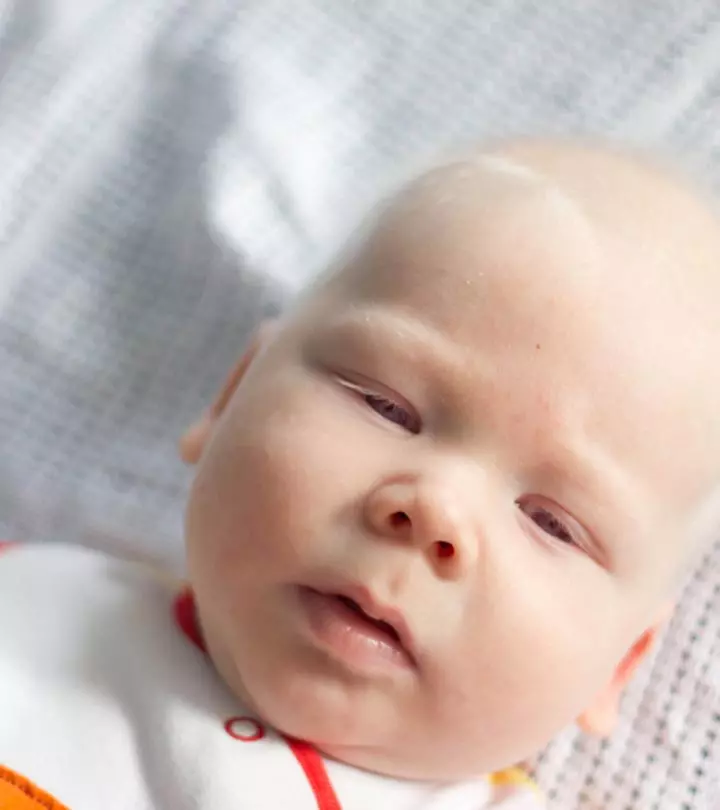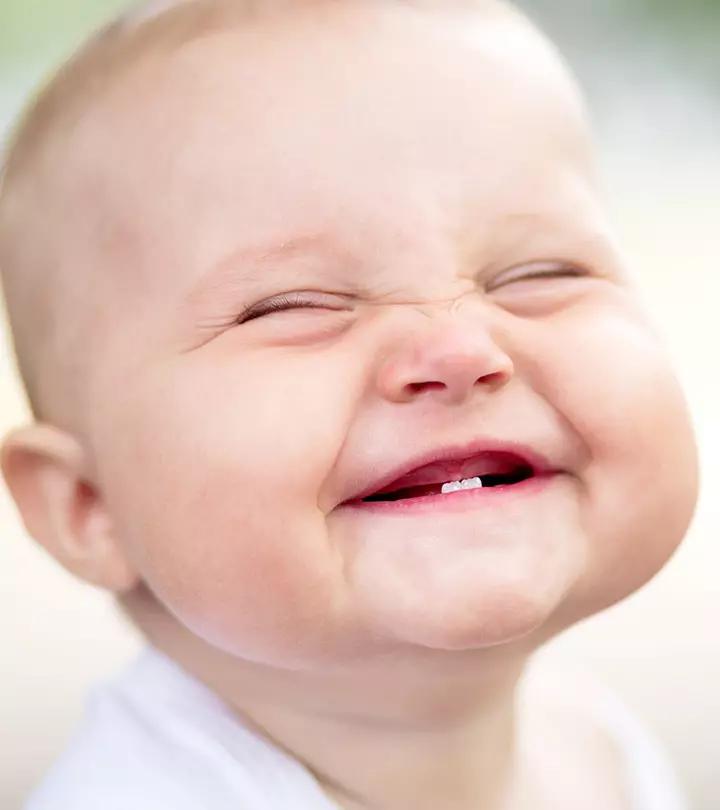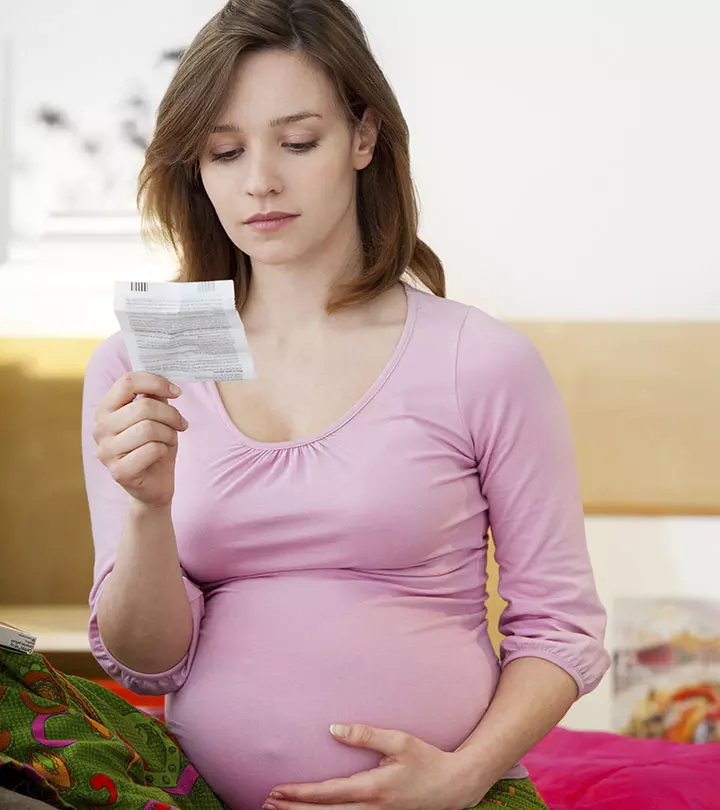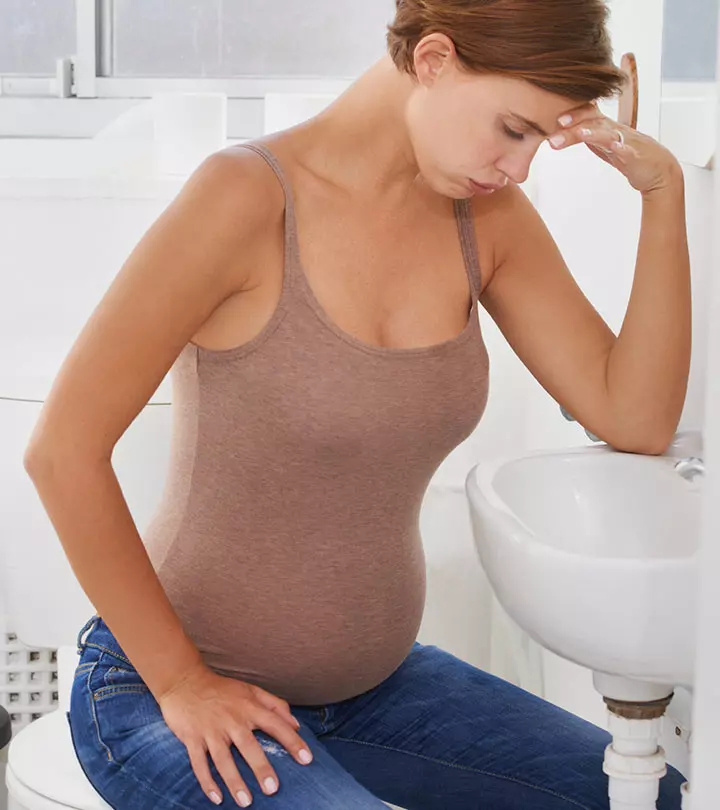
Image: Shutterstock
Congenital nystagmus, or nystagmus in babies, affects about one in every 5,000 live births and usually appears between the ages of six weeks and six months. Nystagmus is an oculariA term used to describe something related to the eyes or their function. condition characterized by recurrent, unpredictable eye movements and random eye jerking. During visual development, your baby’s eyes will wander around to follow objects, voices, or people around them. However, nystagmus causes neonates to have more frequent and consistent eye movements than normal, which can be multi-directional, including horizontal, vertical, and torsional (1). Various medical disorders can cause nystagmus, which may be linked to vision impairment in babies. Timely diagnosis and treatment are crucial for effective management. Read on to know the causes, symptoms, risk factors, diagnosis, and treatments for nystagmus in babies.

Key Pointers
- Babies can be born with sensory or motor congenital nystagmus or develop acquired infantile nystagmus during the first six months of life.
- Jerky, involuntary, and sudden eye movements are hallmark symptoms of nystagmus, and it can also be associated with sensitivity to light or the inability of the eyes to follow objects.
- Nystagmus can be treated with medications or surgery, and eyeglasses or lenses and visual rehabilitation are recommended depending on the severity of vision impairment.
Types Of Nystagmus In Babies
Nystagmus in babies is called infantile nystagmus, and it can be classified into the following three types (2).
1. Congenital nystagmus
Congenital nystagmus, also called infantile nystagmus syndrome, occurs at birth or within the first six months of life. Studies indicate that an estimated 12 children of 10,000 live births in the US have infantile nystagmus syndrome. This accounts for up to 87 percent of nystagmus among the pediatric population (12). This can be further classified into two types.
- Congenital sensory nystagmus: This is nystagmus due to something that interferes with visual information reaching the brain. Babies with congenital sensory nystagmus have abnormal vision. This is called afferent sensory defect since the sensory information, such as vision, to the brain is interrupted. Refractive errorsiEye conditions that occur when the shape of the eye prevents light from focusing properly on the retina , optic nerveiA bundle of nerve fibers that carries visual information from the retina to the brain and retinal problems, and congenital cataracts are common causes of this type of nystagmus in babies.
- Congenital motor nystagmus: According to the American Association for Pediatric Ophthalmology and Strabismus (AAPOS), congenital nystagmus is a more common type. Babies may have normal vision and no underlying causes of this type. This can be due to the brain lacking stability control or motor skills of eye movement. The brain and vision can be otherwise healthy other than nystagmus.
 Things to know
Things to know2. Acquired infantile nystagmus

Acquired nystagmus develops any time after six months of age. This can be due to various reasons such as brain abnormalities, eye and head trauma, and responses to certain medications. Imaging tests such as MRI scansiA non-invasive test that uses radio waves and strong magnetic fields to create detailed images of the body's insides help to identify the underlying causes of acquired nystagmus. According to the American Academy of Ophthalmology, acquired nystagmus is prevalent among 17 percent of all diagnosed pediatric cases of nystagmus (12).
3. Spasmus Nutans Nystagmus
Spasmus nutans nystagmus causes involuntary eye movements in many directions, along with head tilts and nodding. Diagnostic scans such as MRI may be able to diagnose this condition. This condition onsets between six months and three years of age and may gradually improve without interventions or treatments between two and eight years of age (13).
Infantile nystagmus can also be classified based on the eye movements into pendular nystagmus, where the eyes move at an equal velocity in each direction and jerk nystagmus when the eyes move fast to one direction and slowly to the opposite direction.
Signs And Symptoms Of Nystagmus In Babies
Rapid, jerky, involuntary eye movement is the primary symptom of congenital nystagmus in babies. This can be uniplanariA movement confined to one plane. , pendular eye movement. The intensity and frequency of these eye movements may vary in each baby. Nystagmus may occur in one or both eyes. You may not notice eye movements when the baby is asleep.
Other symptoms of nystagmus in babies may include (3):

- Photosensitivity (sensitivity to light)
- Difficulty using eyes to follow objects
- Holding the head in a tilted position
Eyes are objectively normal in babies with nystagmus. There can be a null zone that is a position where the eye oscillations (nystagmus) are less, and the vision is good. Most babies with null zones adopt abnormal head positions for better vision.
Seek the consultation of a pediatric ophthalmologist if your baby has nystagmus. Some symptoms, such as blurred vision, night vision problems, dizziness, and balance issues, are more noticeable in older children.
Laura, a mother and blogger, talks about the signs and symptoms her son exhibited before he was diagnosed with Nystagmus. She says, “Samuel never tracked objects, he never acknowledged when I entered the room, never made eye contact while feeding, and those precious first smiles took a long, long time to come. He still couldn’t sit up very well at 12 months and only started crawling properly at around 20 months… After many appointments, Samuel was finally diagnosed with Nystagmus (i).”
Causes And Risk Factors For Nystagmus

Congenital neurological problems are the most common cause of congenital nystagmus in babies. Some babies may develop neurological issues after birth. Other causes may include (3):
- Congenital cataracts
- AlbinismiA genetic condition characterized by a lack of melanin, a pigment that imparts color to the skin, eyes, and hair.
- Central nervous system illnesses
- Issues with the development of eye movement control
- High refractive errors, such as high myopia (nearsightedness) or astigmatismiA condition where the eye's lens has a different curvature than usual, leading to blurred vision.
- Inner ear inflammation
- Medications such as anti-seizure drugs
In addition, balance and vestibular disorders can also lead to nystagmus in babies. Diseases such as multiple sclerosisiA condition in which the body's immune system attacks healthy nerve cells in the brain and spinal cord , stroke, and trauma may result in acquired nystagmus later in life.
 Quick fact
Quick factDiagnosis Of Nystagmus In Babies

Doctors may observe the eye movements and head positioning of your baby. Detailed family history can be asked since congenital motor nystagmus can be hereditary. A visual acuity test is done in most babies. Congenital motor nystagmus can be associated with relatively better visual acuity than sensory defect nystagmus (4).
You may also notice light sensitivity with strabismus in infants when exposed to bright light. Abnormal photopic cells are seen in electroretinogramsiA diagnostic test that uses electrical signals to study the functional aspects of the retina. . CT scan and MRI scan are needed to look for neurological causes of nystagmus. Congenital cataractsiAn eye condition that causes the eye's lens to become cloudy. , ocular albinismiA genetic condition that causes reduced vision and sensitivity to light , and optic nerve hypoplasiaiCondition characterized by incomplete or improper development of a specific organ. can be observed on a slit-lamp exam (5).
 Quick fact
Quick factTreatment For Nystagmus In Babies
Nystagmus treatment primarily focuses on the correction of refractive error. Sensory deficit of vision in nystagmus cannot be corrected. Existing treatments strategies help to reduce the intensity and frequency of congenital nystagmus.
Treatments for nystagmus may include (6):
- Pharmacological treatments: Various drugs such as diethyl propionate, baclofen, gabapentin, and botulinum toxin injection improve visual acuity and reduce the frequency of nystagmus.
- Surgical treatments: Kestenbaum-Anderson resection and other resection procedures are surgical treatments for improving abnormal head posture and reducing the frequency of eye movements. Tenotomy (eye muscle removal and reattachment) and extraoculariAnything (including muscles) situated external to the eyeball. muscle resection or a combination of these surgeries is also recommended.
- Vision rehabilitation: This is recommended for babies who are born with vision impairments, and may be considered as the baby grows older. Rehabilitation training teaches children to use electronic or optic magnification devices and other adaptive ways.
- Eyeglasses and contact lenses: Babies with refractive errors are provided with eyeglasses or lenses to correct the refractive error. These treatments do not correct nystagmus, and only improve vision. Eye patches are often recommended to prevent complications of refractive problems such as lazy eye (amblyopia) in children.

All these procedures help improve nystagmus, but do not cure it. Babies may receive treatment for underlying causes of any issues that are present.
Frequently Asked Questions
1. Can nystagmus in babies go away?
The prognosis of nystagmus depends on the underlying cause. Babies may not outgrow congenital nystagmus due to developmental issues. Acquired nystagmus due to treatable conditions may go away after treating the underlying cause. For example, nystagmus due to exposure to certain medications may disappear when the compound is cleared from the body.
2. Is nystagmus linked to autism?
Autism and nystagmus may be linked. According to a population-based study in children younger than 18 years conducted using an optimum database, children with autism are nearly five times more likely to have nystagmus than children without autism (7). This study also found that autism could be linked to various ophthalmologic disorders (8). If your baby has nystagmus and you have concerns about their development, you may consult a doctor who is an autism spectrum disorder specialist.
3. Is congenital nystagmus serious?
Infantile nystagmus syndrome is usually mild, and its severity does not increase. It is seldom associated with any other disorder (9).
4. How does nystagmus affect learning?
Some children with nystagmus may be able to read normal-sized print with the help of adapted materials. However, it can be tiresome for long durations due to the additional time and effort involved in focusing. Such children’s vision may change throughout the day and worsen when they are tired or stressed. They may also find it difficult to perceive depth and distance, which may interfere with mobility or when attempting some sports activities (10).
Congenital nystagmus is an ophthalmologic condition that can be hereditary or acquired in the first six months of infancy. Seek immediate medical care if you observe rapid eye movements in your newborn. Refractive error can be corrected, and the severity and frequency of movements may be reduced with present treatment options, but sensory vision deficits cannot be fully addressed. Early identification and interventions to manage eye problems may help improve the quality of life. If the underlying condition is treatable, acquired nystagmus may also be easily addressed.
Infographic: Does Vision Therapy Help Nystagmus?
Vision therapies may help to improve visual functions in nystagmus. These therapies enhance the connection between the brain and eyes for improved vision and related skills. Check out the infographic to know the outcomes of vision therapy in children with nystagmus.
Some thing wrong with infographic shortcode. please verify shortcode syntax
Illustration: Congenital Nystagmus In Babies: Types Symptoms And Treatment

Image: Dall·E/MomJunction Design Team
Investigate the improvement of Nystagmus after Retinoblastoma treatment. We will look at the underlying causes, treatment options, as well as outcomes of this condition.
Personal Experience: Source
MomJunction articles include first-hand experiences to provide you with better insights through real-life narratives. Here are the sources of personal accounts referenced in this article.
i. Your stories: Congenital Nystagmus.https://forlittleeyes.com/2014/11/05/wobbly-wednesday-your-stories-congenital-nystagmus/
References
- X-linked Infantile Nystagmus.
https://medlineplus.gov/genetics/condition/x-linked-infantile-nystagmus/#frequency - R V Abadi and A Bjerre; Motor and Sensory Characteristics of Infantile Nystagmus.
https://www.ncbi.nlm.nih.gov/pmc/articles/PMC1771304/ - Nystagmus.
https://www.aoa.org/healthy-eyes/eye-and-vision-conditions/nystagmus?sso=y - Katie Flickinger and Jeremiah P. Tao, How to Assess and Treat Infantile Nystagmus.
https://www.aao.org/eyenet/article/how-to-assess-treat-infantile-nystagmus - Morgan Bersch, et al., The clinical evaluation of infantile nystagmus: What to do first and why.
https://www.ncbi.nlm.nih.gov/pmc/articles/PMC5665016/ - Kimberly Penix, et al., Nystagmus in pediatric patients: Interventions and patient-focused perspectives.
https://www.ncbi.nlm.nih.gov/pmc/articles/PMC4551307/ - Melinda Y Chang, et al., Prevalence of Ophthalmologic Diagnoses in Children With Autism Spectrum Disorder Using the Optum Dataset: A Population-Based Study.
https://pubmed.ncbi.nlm.nih.gov/32896499/ - Eyeing the connection between autism and vision.
https://www.thetransmitter.org/spectrum/eyeing-the-connection-between-autism-and-vision/?fspec=1 - Nystagmus.
https://www.mountsinai.org/health-library/symptoms/nystagmus - Nystagmus booklet for teachers.
https://nystagmusnetwork.org/wp-content/uploads/2016/04/Nystagmus-Network-booklet-for-teachers-email-version.pdf - Nystagmus.
https://aapos.org/glossary/nystagmus - Clinical Guidelines: Childhood Nystagmus Workup.
https://www.aao.org/education/disease-review/clinical-guidelines-childhood-nystagmus-workup#:~:text=Prevalence%20and%20Risk%20factors,5 - Nystagmus in Babies & Children.
https://www.healthychildren.org/English/health-issues/conditions/eyes/Pages/nystagmus-in-babies-and-children.aspx
Community Experiences
Join the conversation and become a part of our nurturing community! Share your stories, experiences, and insights to connect with fellow parents.
Read full bio of Dr. Garima Garg Seth
Read full bio of Dr Bisny T. Joseph
Read full bio of Rohit Garoo
Read full bio of Vidya Tadapatri

















